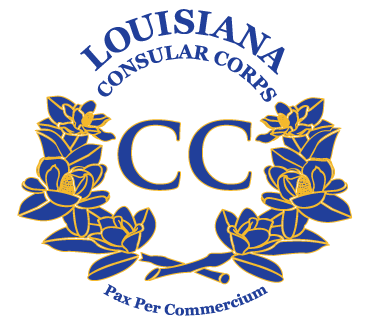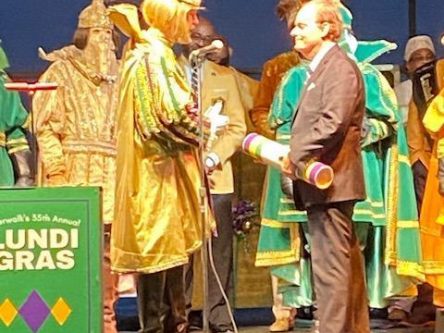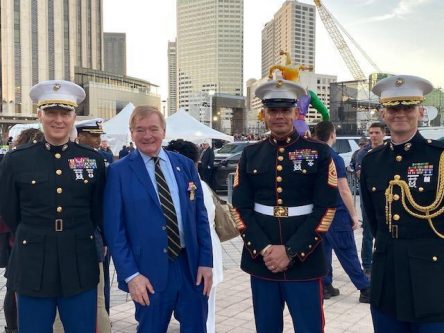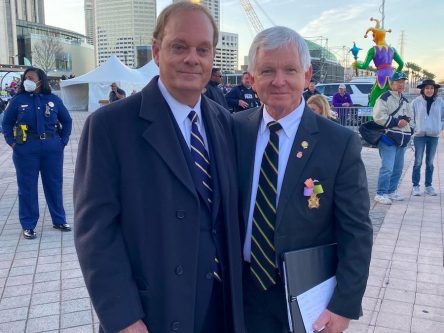French President Emmanuel Macron visit to New Orleans!
It was a great honor for the Consular Corps to welcome French President Emmanuel Macron, and his wife, Brigitte Macron, to New Orleans.
Governor John Bel Edwards and Minister for Europe and Foreign Affairs Catherine Colonna signed a memorandum of understanding, “to further expand and enhance the strong cultural connections between France and Louisiana in the areas of the economy, clean energy and the environment.”
French adviser to assist Louisiana in transitioning to a cleaner energy under the signed agreement https://lnkd.in/gSef6vTs
The visit by Macron will also reinforce cultural connection and the french language taught in Louisiana.
Congratulations to our colleague Nathalie Beras, Consul General of France in Louisiana, for this historic visit.
The Louisiana Consular Corps Annual Christmas Party
We can’t thank David Schulingkamp enough for hosting such a wonderful Christmas Party this year. The annual Christmas party is of particular importance to the consular corps, in that it provides a chance for us to interact and network as we pursue our various endeavors.
The Mayor of New Orleans, LaToya Cantrell met with the Consul General Ruth Emmerink of the Kingdom of The Netherlands, Esther van Geloven, Senior Policy Advisor at the Consulate in Miami, and Deirdre McGlinchey the Honorary Consul of the Netherlands in New Orleans,
“The City of New Orleans is focused on a range of priority industries where we can collaborate with our Dutch leaders and partners. The relationship between the Netherlands and New Orleans dates back hundreds of years with the first Netherlands consular representative in New Orleans being appointed in 1815, a dozen years after Thomas Jefferson asked Dutch bankers to help finance the Louisiana Purchase.”
The Honorary Consul Deirdre McGlinchey also hosted a Maritime Networking Reception for Dutch companies attending the International Boat Show. In addition, a mobile passport station for Dutch Citizens was offered by the consular staff while visiting New Orleans.
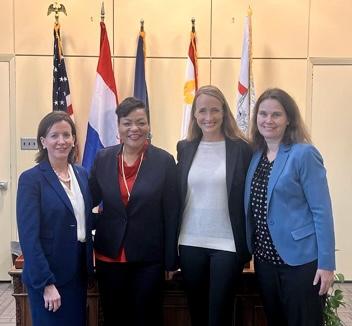
On November 4, the Honorable Tito Livio Morales Burelo, Consul of Mexico, hosted the U. S. Department of State and many local law enforcement, military, charities, state government and the Louisiana Consular Corps at the second in a series of Anti-Human Trafficking presentations in New Orleans. The Consular Corps was also represented by the Dean Bret A. Clesi, Honorary Consul General of Albania, Executive Committee Member Cecilia Kjellgren, Honorary Consul of Sweden, Cesar Lurati, Honorary Consul of Uruguay, newly-appointed Consul of Honduras, the Honorable Christian Mendoza and his Vice Consul, the Honorable Claudia Oyuela Guzman.
The panel discussion outlined the growing human trafficking for labor and sex trafficking victims, particularly focusing on the Latin American countries, as well as providing a plethora of local/state/federal resources available to us.
On Thursday, Nov. 3, Mayor LaToya Cantrell met with the Association of Former Members of Congress and the Congressional Study Group on Germany, comprised of members of the German Parliament and business executives in technology, energy and other industries to share the City’s priorities, provide insight into challenges our residents are facing and discuss how both New Orleans and Germany can work together to address and mitigate these issues.
The German delegation was led by German Economic Institute Director Dr. Michael Hüther and included numerous corporate executives and directors from blue-chip companies based in Germany and throughout Europe, as well as current and former members of the German Parliament.
Attendees from the Cantrell Administration included Chief of Staff Clifton Davis, Director of International Relations Rosine Pema Sanga, Director of Intergovernmental Relations Arthur Walton, External Relations Manager Zach Monroe of the Office of Resilience and Sustainability and Honorary Consul for the Federal Republic of Germany Susanne Cooper.
https://content.govdelivery.com/accounts/LANOLA/bulletins/33638b5
Hon. William H. Hines, Honorary Consul of Portugal in New Orleans and Vice Dean of the Louisiana Consular Corps, will receive the prestigious Galvez Cup at the Azucar Ball hosted by the New Orleans Hispanic Heritage Foundation. Bill will be recognized by the Foundation for his leadership roles in many cultural and educational institutions and for his long-standing commitment to the nonprofit community of New Orleans.
Bill will receive the 2022 Galvez Cup during the 30th Anniversary Azucar Ball at the Hyatt Regency Hotel.
On October 6, Harrison Crabtree, Business Development & Research Manager with GNO, Inc., met once again with the Consul General of Ireland Robert Hull, from the Irish Consulate Austin and representatives from IDA Ireland, in an effort to foster collaboration and strengthen the Greater New Orleans Economy.
On October 3, the Honorable Dr. Earl Quinn Peeper, Honorary Consul of Great Britain in New Orleans, hosted a meeting and dinner in New York City in the presence of HRH Princess Anne, the Princess Royal, sister of HM King Charles III of Great Britain.
At our September luncheon meeting on Tuesday, September 20 at The Four Seasons Hotel, we were honored to have Robert Hull, Consul General of Ireland from Austin as our guest speaker. We were also pleased to have Ed Webb, CEO of WTCNO and Harrison Crabtree, Business Development & Research Manager with GNO, Inc., as our guests.
September 17 – The Hong Kong Economic and Trade Office in New York partnered up with the New Orleans Jazz Museum for an amazing performance this weekend!

On Saturday, September 17th, Dr. Zoltan Gombos, Honorary Consul of the Slovak Republic, hosted a meeting at Antoine’s Restaurant for a delegation of Hungarian government officials visiting New Orleans.
Pictured clockwise from left: Mr. Bela Kocsy, Agricultural Attache’ at the Embassy of Hungary in Washington, DC, the Honorable Bret A. Clesi, Dean of the Louisiana Consular Corps and Honorary Consul General of the Republic of Albania, Honorary Consul Gombos, the Honorable Zsolt Lang, Member of the Hungarian Parliament and Undersecretary for Regional Development overseeing the capitol city, Budapest.
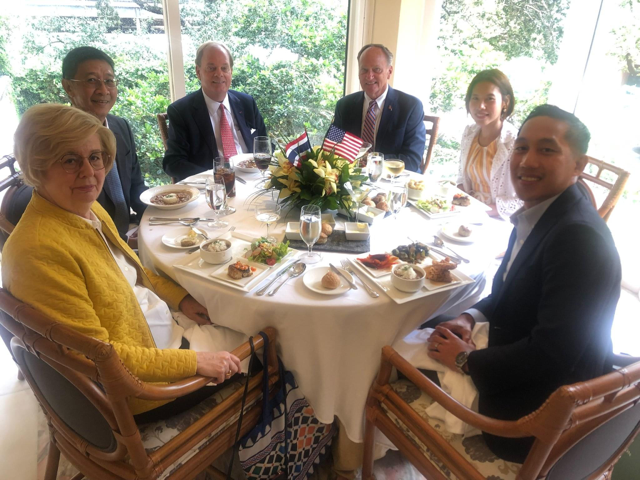
Lunch meeting in New Orleans with the Royal Thailand Embassy delegation on July 12, 2022.
(L – R) The Hon. Conny Willems, Ambassador Manasvi Srisodapol, the Hon. Bret Clesi, the Hon. Greg Beuerman, Minister Counsellor Chuliepote Isarankura Na Ayudhaya, and Counsellor Thitiwat Sukhasvasti Na Ayudhya
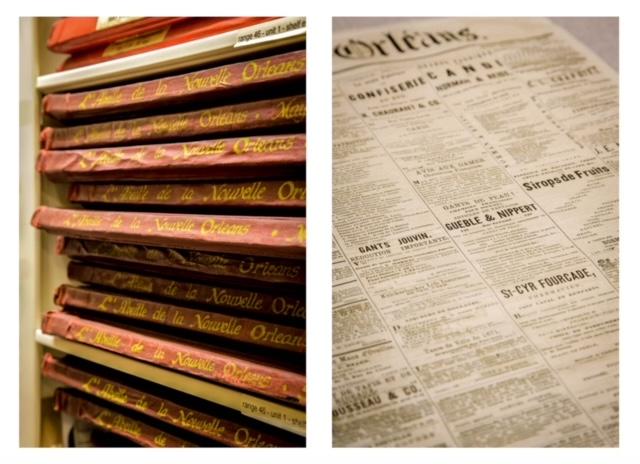 An exhibit on the European influences in and around New Orleans, presented by the Consul General of France (open air exhibit at 2406 Prytania Street).
An exhibit on the European influences in and around New Orleans, presented by the Consul General of France (open air exhibit at 2406 Prytania Street).
City names, street names, surnames, landmarks, flavors, architecture, the traces of Europe are multiple and present everywhere in the United States. They constitute the common denominator of a rich history, made of varied individual and collective journeys, discoveries, pains and success.
They are French, German, Spanish, Italian, Czech, Greek, Croatian, Swedish, Irish… for some of them, the port of arrival was New Orleans.
In successive waves of immigration, they founded families and lineages, brought their culture and skills, and left their mark on the territory.
This exhibition explores these influences through stories, places and personalities to illustrate these traces of Europe at the heart of the Louisiana identity.
The New Orleans Bee (France)
The French influence in this part of the United States is first of all a name: Louisiana.
Beyond the undeniable cultural contribution in the arts, cuisine, urbanism and Louisiana society, it is first and foremost with a language and surnames that France leaves its strongest imprint, at the corner of a street, a grave or a Facebook account.
L’Abeille de La Nouvelle-Orléans was a French-language newspaper founded by François Delaup on September 1, 1827 and which ceased publication in 1925. L’Abeille featured opinionated journalism, focusing on the literary, theatrical, and musical life of the city, but also covered news from Europe and France in particular. The publication also included steamboat schedules, the arrival of new cargo shipments, and personal ads that captured the life of the times.
The Croatian Connection
Croatians played a fundamental role in the cultivation of oysters, which is the basis of Louisiana’s gastronomy. New Orleans was one of the crossroads of Croatian immigration to the United States in the early 19th century. Many of the newcomers came from towns and villages along the Dalmatian coast of the Adriatic Sea. Settling among the fishing communities of Plaquemines Parish such as Olga, Empire, Buras and Port Sulphur, they imported their oyster farming skills. At 30 years old, Luke represents the 5th generation of oyster farmers in the Cibilich family and is one of the youngest in the parish. He is pictured here on his boat on the outskirts of the village of Empire.
The Czech Beads
Everybody knows what Beads are, those famous necklaces thrown to the crowd from Mardi Gras floats? Before the advent of plastic in the 1960s, beads were made of glass for Carnival and were distributed on a limited basis. So in the early 50’s, the Krewes called upon some Czechoslovakian companies to make them. Here we can see the refined composition of these necklaces and the characteristic colors used at that time.
Kira, pictured below, is Registrar & Digital Initiatives Manager for the Louisiana State Museum, which preserves a collection of these Czechoslovakian-made beads. She is herself a descendant of Czech and Slovak families.
A Swedish immigrant named Hammond
Hammond is a small town northwest of Lake Pontchartrain, well known to New Orleanians for its Swedish roots and foundation. Peter Hammond (1798-1870), anglicized from Peter av Hammerdal (Peter of Hammerdal) was a Swedish immigrant who settled in the area around 1818.
This sailor, briefly imprisoned by the British at Dartmoor Prison during the Napoleonic Wars, escaped during a riot and landed in New Orleans. Hammond used his savings to purchase a then inexpensive piece of land northwest of Lake Pontchartrain, where he founded the eponymous town. His grave, along with that of his wife Caroline and their three children, is located near the center of town under the oak tree pictured here.
Cajun-Acadian World War II Commemoration at the National World War II Museum, April 26, 2022
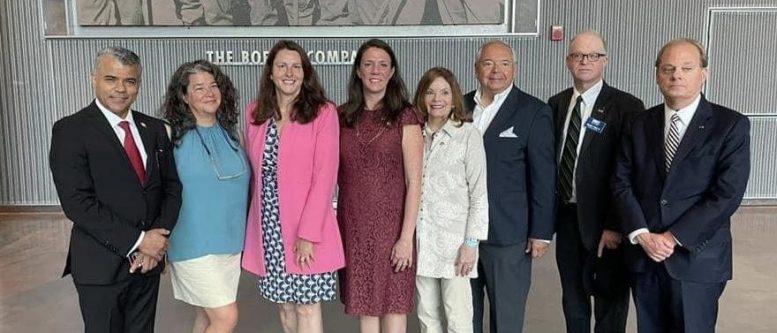
On February 28, 2022, Lundi Gras, Dean Bret Clesi and the Consular Corps greeted Rex, King of Carnival, on the Mississippi Riverfront in New Orleans.
In the context of the French Presidency of the European Union Council, Deputy Ambassador Michael Curtis was invited to Louisiana by the French Consul General Nathalie Beras from February 9 to February 13.
